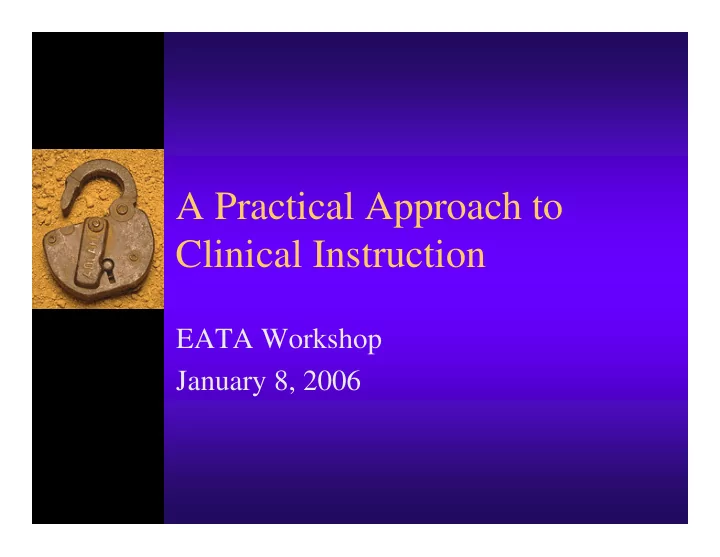

A Practical Approach to Clinical Instruction EATA Workshop January 8, 2006
Agenda ♦ Opening Remarks – Students’ Skill Level – Introduction of Global Concepts – Situational Supervision – Strategic Questioning – Feedback ♦ Application of Concepts – Small group breakout sessions ♦ Closing the loop – Group Q & A
AT Student’s Skill Levels ♦ Novice – Possesses minimal skill level and may have basic knowledge of concepts/ theories. ♦ Intermediate – Possesses increased skill level but not yet proficient. – Possesses increased experience base. – Possesses ability to understand, apply, and analyze concepts Advanced – Possesses advanced skill set and is reaching or has achieved proficiency – Possesses significant experience with concept/skill – Possesses ability to synthesize and evaluate information
Global Concept ♦ When evaluating learning models, a trend exist in the similarities between the continually evolving process of: – Supervision – Questioning – Feedback
SQF Model High Supervision Questioning Feedback Low Inexperienced Experienced ATS’s Experiences and Exposures
Situational Supervision Relationship to Clinical Education
Blanchard’s Situational Leadership (1985) S3 S2 high Supporting Coaching Capable, but Disillusioned Supportive Behavior Cautious Contributor Learner D3 D2 D4 D1 Self-Reliant Enthusiastic Achiever Beginner Delegating Directing S4 S1 low Directive Behavior high
Situational Supervision ♦ If student is unable/unsure, the ACI should provide – direction, coaching or support as needed ♦ If student is able to complete the task independently, the ACI should – observe and delegate – allow ATS to report results
SQF Model High Supervision Questioning Feedback Low Inexperienced Experienced ATS’s Experiences and Exposures
Strategic Questioning Relationship to Clinical Education
Questioning Athletic Training Students ♦ Non-strategic Questioning – “Traveling without a map” – “Destination California; got as far as…..” ♦ Strategic Questioning – “AAA Trip Tic” – Stimulating cognitive processing at multiple levels for the specific purpose of stimulating critical thinking
Terminology to stimulate different levels of thinking (Bloom) ♦ Knowledge � name, describe, define, list ♦ Comprehension � give examples, identify, explain ♦ Application � utilize, apply, based on … ♦ Analysis � compare, separate, determine ♦ Synthesis � create, design, develop ♦ Evaluation � justify, summarize, predict, judge
Strategic Questioning through Funneling ♦ Funneling is a questioning technique that seeks to assist the student in processing information in a very specific sequence (Priest & Gass, 1997)
Strategic Questioning through Funneling – What Level: what do they know to be true about a given topic/concept/technique? – So What Level: what do they know about applying basic information and how well do they understand concepts/application? – Now What: what is relevant; what meaning can be derived; what are the implications, consequences?
Start with asking What? What Questions : are asked most frequently and target knowledge, comprehension & application
Next ask So What? WHAT? So What Questions: fewer number of so what questions are asked; target analysis & synthesis
Next ask Now What? WHAT? SO WHAT? Now what Questions: are posed least frequently and target synthesis and evaluation.
Finally ask Now What? SO WHAT? WHAT? WHAT? NOW
Strategic Questioning Through Funneling ♦ Always start with WHAT level questions and progress toward NOW WHAT questions. ♦ Number of questions asked or complexity of questions asked should be determined by level of experience and knowledge student has with given topic/experience
SQF Model High Supervision Questioning Feedback Low Inexperienced Experienced ATS’s Experiences and Exposures
Feedback “the return of information about the result of a process” American Heritage Dictionary, 2nd ed “… should encourage and provide feedback when new and/or difficult clinical situations arise” “ constructive feedback should be frequent and objective” Weidner & Henning, 2004
Formative vs. Summative ♦ Formative: ♦ Summative: ♦ “… formative ♦ “…summative evaluation is specific evaluation refers to to a particular situation general feedback at a particular time.” about overall performance.”
Feedback in Action An AT student attempts to demonstrate a thumb spica. It does not limit thumb hyperextension. ACI asks the student to check bilaterally if thumb hyperextension has been limited . AT student recognizes that the thumb spica technique was inappropriate based on his/her understanding of limiting range of motion. ACI provides verbal feedback on how to improve the student’s thumb spica skill and demonstrates appropriate technique.
Feedback in Action Formative Feedback = ACI immediately praises/ corrects the student’s specific actions (appropriate technique & application of tape) Summative Feedback = ACI assesses the student’s overall performance of completing a thumb spica to prevent thumb hyperextension and provides praise and suggestions for improvement
Novice Skill Level Minimal skill level and new/basic understanding of a concept/skill -Requires direction � coaching supervision -Requires lower level questioning -Requires frequent & specific feedback
Intermediate Skill Level Has a basic understanding of a concept Has had some basic experience and analysis of a concept -Requires coaching � supporting supervision -Requires moderate level questioning -Requires frequent & specific feedback to match ATS’s skill level
Advanced Skill Level Has a thorough understanding of a concept/ skill Has had significant experience with concept/ skill Has an ability to synthesize information -Requires supporting � delegating with minimal supervision -Requires advanced level questioning -Requires frequent & specific feedback to match ATS’s skill level
SQF Model High Supervision Questioning Feedback Low Inexperienced Experienced ATS’s Experiences and Exposures
Application of Concepts Breakout session
Closing the Loop The SQF Model: Putting It All Together
SQF Model High Supervision Questioning Feedback Low Inexperienced Experienced ATS’s Experiences and Exposures
SQF Model High Supervision Questioning Feedback Low Inexperienced Experienced ATS’s Experiences and Exposures
SQF Model High Supervision Questioning Feedback Low Inexperienced Experienced ATS’s Experiences and Exposures
Thank you for your participation. If you have additional questions, please contact us at: ♦ Presenters: – Dr. Mary Barnum: mbarnum@spfldcol.edu – Ms. Carrie Graham: carrie.graham@uconn.edu – Dr. Susan Guyer: mguyer@spfldcol.edu – Dr. Linda Levy: levy@mail.plymouth.edu ♦ Facilitators: – Dr. Amy Everitt: amy.everitt@salemstate.edu – Professor Cristina Haverty: CHaverty@Lasell.edu – Thank you to the students who assisted in this workshop!
Recommend
More recommend